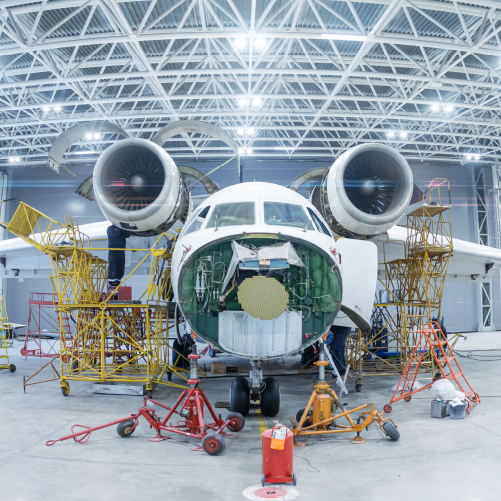Aerospace Applications
Aerospace
Long and intricate suppliers and the criticality of tracing every component in this long chain makes permanent marking a crucial necessity of the aerospace industry. The industry is vulnerable to disasters and uses multiple metal surfaces from stainless steel to aluminium to titanium requiring precision marking techniques to trace components. Laser marking is key to this industry as the parts meet highest standards of quality and safety and the marking should be readable to the human eye as well as scanners.
Surfaces For Marking
Day and night markings on avionic panels |micro and major electrical, mechanical and electronic constituents | Chips, circuit boards and other navigation devices | wings and blades | thrusters and actuators | branding and bar coding on exteriors

In the aerospace industry, both dot peen marking machine and laser marking machines play crucial roles in part identification, traceability, and compliance with industry standards. Each technology offers unique advantages, and their usage depends on the specific requirements of aerospace components. Here’s an overview of how dot peen and laser marking machines are utilized in the aerospace sector:
### Dot Peen Marking:
- Marking Process:
– Dot peen marking involves creating a series of small, closely spaced dots on the surface of a material using a pneumatically or electromagnetically driven stylus.
- Materials:
– Dot peen is suitable for marking a wide range of materials, including metals and alloys commonly used in aerospace components.
- Applications:
– Part and assembly identification.
– Serial numbers for traceability.
– Date codes, lot numbers, and other alphanumeric markings.
– Compliance with aerospace standards.
- Advantages:
– Durable and deep markings.
– Well-suited for harsh environments.
– Compliance with aerospace material and marking specifications.
– Cost-effective for certain applications.
### Laser Marking:
- Marking Process:
– Laser marking involves using a laser beam to alter the surface of a material, creating permanent and high-contrast marks without physical contact.
- Materials:
– Laser marking is versatile and can be applied to a variety of aerospace materials, including metals, composites, and certain polymers.
- Applications:
– 2D matrix codes for part tracking.
– Component serialization for traceability.
– Fine and detailed markings, including logos and graphics.
– Compliance with aerospace standards and regulations.
- Advantages:
– High precision and fine detail.
– Non-contact process, reducing wear on equipment.
– Faster marking speed for certain applications.
– Flexibility in terms of design and customization.
### Integration in Aerospace Production:
- Quality Assurance:
– Both dot peen and laser marking technologies are essential for ensuring the quality and traceability of aerospace components throughout the manufacturing process.
- Compliance:
– Aerospace components often require compliance with industry-specific standards and regulations. Both marking technologies can be configured to meet these stringent requirements.
- Part Lifecycle Traceability:
– Traceability is critical in the aerospace industry, and markings created by both technologies facilitate tracking components from production to installation and maintenance.
- Efficiency in Production Lines:
– Integration of dot peen and laser marking machines into automated production lines helps streamline the marking process, ensuring efficiency and consistency.
In summary, dot peen and laser marking machines are integral to the aerospace industry, offering solutions for part identification, traceability, and compliance with industry standards. The choice between the two depends on material specifications, precision requirements, and the nature of the markings needed for a particular aerospace application.

